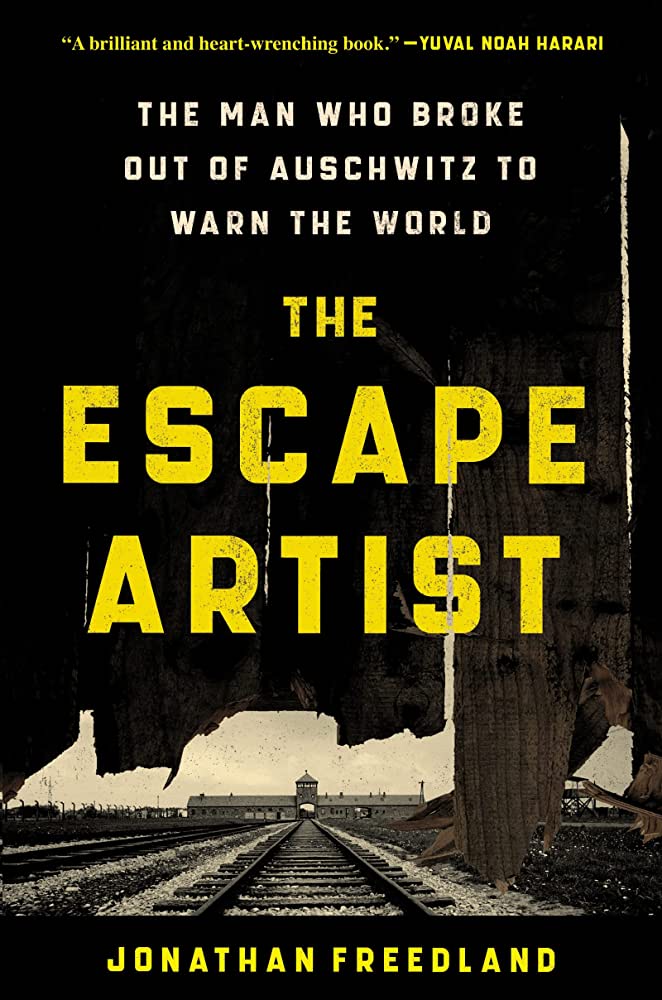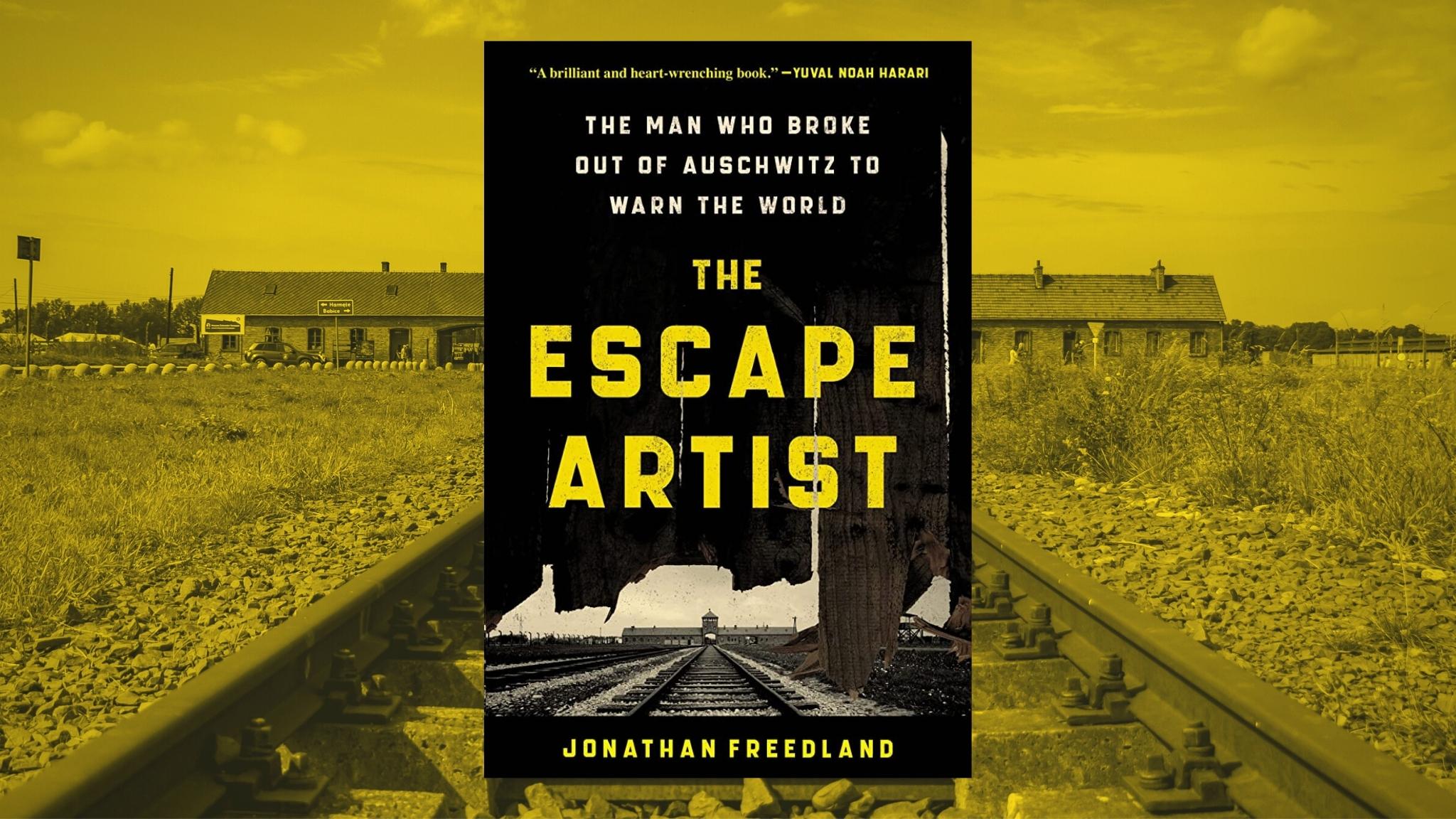The Escape Artist: The Man Who Broke Out of Auschwitz to Warn the World by Jonathan Freedland
Jonathan Freedland, longtime journalist for The Guardian, nonfiction writer and novelist, has finally given Holocaust survivor and hero Rudolf Vrba a more balanced portrait than his 1963 memoir I Cannot Forgive and with it well deserved recognition for later generations of readers and scholars. The Escape Artist, subtitled The Man Who Broke Out of Auschwitz to Warn the World is as exciting as a fictional edge-of-your-seat thriller and all the more impressive because it is a factual and significant addition to the canon of Holocaust history. The Escape Artist was first published in hardback in 2022 in Great Britain by John Murray Publishers and later that year by Harper Collins. It has recently been released in paperback.
How a Documentary Inspired the Book
In the author’s introductory note Jonathan Freedland wrote, “When I was 19 years old, I went to the Curzon Cinema in Mayfair in London to see the epic nine-hour documentary Shoah.” The term is a Hebrew word meaning catastrophe and in this instance refers to the killing of six million Jews during WWII by Nazi Germany and its collaborators. He went on to state “The film left a deep mark, but one of the interviewees stayed with me more than any other. His name was Rudolf Vrba.”
Shoah was a French documentary, eleven years in the making, directed by Claude Lanzmann. He conducted interviews, frequently at actual Holocaust sites, with eyewitnesses, survivors and perpetrators. During the film as he testified to the horrors, Vrba revealed the fact that he had escaped Auschwitz. That he was only 19 and had somehow already managed to survive two years in this death camp deeply impressed the Oxford University student who never forgot him.
Thirty years later, realizing few had heard of Vrba who had died in 2006, Jonathan Freedland felt compelled to inform the world about the enormous risks taken by The Escape Artist in his effort “to tell the world the truth hidden under a mountain of lies.”
As he began his research he learned that Rudolf Vrba’s first wife and mother of his two daughters, Greta, also a concentration camp survivor, was not only alive but living in north London. On several summer afternoons during the height of the pandemic in 2020, he met with her in her garden to talk about Rudi, the young man she first knew as Walter Rosenberg, and their shared history. Not long after their final conversation, she passed away but not before giving the author a red suitcase filled with letters from Rudolf.
The author spent many hours on the telephone interviewing Rudi’s second wife and widow, Robin, who resides in New York. She spoke of the man he became, of their love and the memories he entrusted to her. He expanded and deepened his research with official documents, court transcriptions, testimonies, reports and accounts. There are footnotes, an extensive bibliography and index at the conclusion of this important work of nonfiction.
After leaving the cinema in 1986, Jonathan Freedland stated his conviction, “that the name of Rudolf Vrba deserved to stand alongside Anne Frank, Oskar Schindler and Primo Levi, in the first rank of stories that define the Shoah.” He expresses the hope that Rudolf Vrba “might escape our forgetfulness and be remembered.”
True Story of An Escape From Auschwitz
The Escape Artist is the harrowing true story of how Prisoner #44070, Walter Rosenberg, age 19, and his co-conspirator Prisoner #29162, Alfred Wetzler, age 25, were the first two Jews to succeed in escaping from the Auschwitz death camp. Other prisoners had made it out of the camp but all were either killed upon capture or brought back to be tortured and publicly executed as examples.
Walter and Fred, both from Trnava, Slovakia, were only slightly acquainted before connecting in Auschwitz where they became friends who looked out for one another. Jewish communities there thrived before WWII but 77% of their fellow Slovakian Jews were killed by the Nazis primarily through deportations to concentration camps beginning in 1942.
Shamefully, lists of the Jewish residents were provided to the Germans by Slovakian officials who cooperated in their removal. Neither of these men were devoutly religious Jews; Walter aspired to be a scientist and Fred was a Communist. Jews were barred from attending schools or universities when the Nazis came to power.
Walter was 13 when these doors were closed to him. He was highly intelligent; a true autodidact who mastered multiple languages from books and worked his way through a discarded chemistry textbook eager to continue his education. He was one of those rare individuals with an eidetic memory popularly termed photographic with nearly total recall. Rosenberg was later compared to a cat with nine lives; by the time he escaped from Auschwitz, he had used up most of them.
Three examples: He had been transferred from Majdanek Camp to Auschwitz shortly before a massive execution took place; while on a grueling work detail that resulted in the deaths of 98 of the 100 men in his unit, he was spared when a French engineer changed his assignment; a Slovakian Kapo moved him out of a line headed for the gas chamber.
Eventually, his language skills helped him obtain an assignment in Kanada aka “The Land of Plenty”; the vast storehouses where all prisoners’ worldly goods including clothing were stripped away and swiftly sorted upon the arrival of each transport, all becoming Nazi property. Although it was forbidden and if caught the penalty could be instant death, the workers in Kanada managed to steal additional food and clothing beyond the socks and footwear which they were tacitly permitted to take. They also were housed separately and received better food rations.
Eventually Walter Rosenberg, like Fred Wetzler, was given one of the trusted positions of camp registrar allowing them to circulate with greater ease in Auschwitz-Birkenau. They used this access to obtain invaluable information about executions, schedules and the overall camp operations enabling them to inform the world about the plans to eliminate the last largest remaining Jewish population in Europe; the 800,000 Hungarian Jews.
Weeks of Planning Led to a Continued Life Post-War
After weeks of meticulous planning the two men executed their escape on April 7, 1944. Please read The Escape Artist to discover the truly hair-raising details. They reached the Slovak border on April 21 and found welcoming shelter at the headquarters of the Jewish Council in Žilina where they gave comprehensive testimony which became the official 40 page document called the Vrba/Wetzler Papers aka the Auschwitz Protocol. Both men were given a nom de guerre and issued new identification papers ostensibly proving they were non-Jews. Walter Rosenberg became Rudolf Vrba, the name he opted to keep post-war.
Fred Wetzler was now Jozef Lanik who became a member of the national partisan movement. He later reclaimed his birth name, living and working in Slovakia until his death in 1988. Rudolf Vrba bravely chose to leave his safe hideaway and became a machine gunner for the Slovak Resistance movement. Rising to the rank of Senior Sergeant he became a decorated war hero receiving the Czechoslovak Medal for Bravery, the Order of Slovak National Insurrection and the Order of Meritorious Fighter.
Well-Deserved Recipient of National Jewish Book Award
Ultimately Rudolf Vrba completed his interrupted education and earned a Doctorate in Chemistry. The Escape Artist made the journey from Kanada in Auschwitz to Vancouver, Canada where he became an associate professor. It was not an easy journey for a man distrustful of all, angry and bitter more Jews were not saved after his courageous escape and warning to the world’s authorities.
He could not have known Jan Karski, the heroic Polish diplomat and later tenured professor at Georgetown University, met President Franklin Roosevelt and Associate Supreme Court Justice Felix Frankfurter in 1943 to brief them. He provided his eyewitness accounts of the visits he made to the Warsaw Ghetto and the continuing deportation of Jews to what the world needed to know were death camps. As with Vrba’s testimony, Karski’s efforts did not result in achieving intervention.
This is merely the tip of the iceberg in this riveting comprehensive biography of Rudolph Vrba. It is an essential addition to the individual stories already part of the collective history of the Holocaust. Jonathan Freedland has received a Jewish Book Council Award for The Escape Artist: The Man Who Broke Out of Auschwitz to Warn the World and merits further accolades for reminding us of the bravery of Rudolf Vrba.
About Jonathan Freedland:

Jonathan Freedland is a Guardian columnist and former foreign correspondent. He is the presenter of BBC Radio 4’s contemporary history series, The Long View, as well as two podcasts, Politics Weekly America for the Guardian and Unholy, alongside the Israeli journalist Yonit Levi. He is a past winner of an Orwell Prize for journalism. He is the author of 12 books, the latest being The Escape Artist: The Man Who Broke Out of Auschwitz to Warn the World. He has written nine thrillers, mostly as Sam Bourne, including The Righteous Men which was a Sunday Times number-one bestseller.





